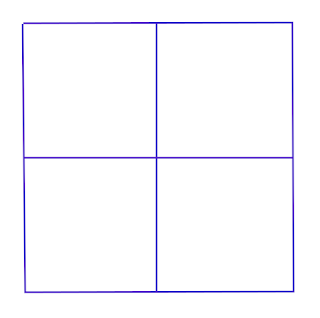Fun with 3x3 boards
I'm sure that most Westerners, who grew up on chess and checkers and coloring books, and are told to always stay within the lines, will think of Tic Tac Toe when I mention a 3x3 board game. Sure, if you want to stay inside the boxes, that's what a 3x3 grid looks like.
But many games are played on the lines, not on the boxes. So here is a basic 3x3 grid.
If you are still seeing a 2x2 grid, let me show where the pieces would go.
What makes this easily-drawn board so neat and compact, is that the lines show how and where the pieces can move.
Technically, that simple board is used in a game called (not surprisingly) Nine Holes. The basic rules for all games on this page:
- each player gets three pieces, the pieces start off the board
- take turns adding pieces to the board
- once all pieces are on the board players can move one piece one square each turn.
- Winner is the first to get three in a row.
It's not the most exciting thing, but you can sketch the board anytime and use pocket change, pebbles, whatever you like. Making games on the fly is always fun, and even a simple game is a mental exercise.
Now, how about adding some diagonals, for a few more moves?
With the same rules as above, this one is known as Tapatan (Philippines) or Achi (Ghana, four pieces per player) or Three Men's Morris.
A related game from India is Tant Fant. Here, the players start off with their three pieces setup along their edge of the board, and the winner must get a three-in-a-row at any position other than their starting position. For a slightly harder game, only allow a diagonal three-in-a-row to win.
Achi and Tant Fant are also described at the Bead Game site, and I like the art style they use over there.
We can add a few more lines for the next game in this series:
This is the board used by the Zuni (Native American) game of Picaria. The is one extra rule: you can't use the center space until all pieces have been added to the board.
There is a more advanced Picaria where those other four intersections are also playable. Essentially this:
But it's not a 3x3 game board anymore, and I think you should start with four stones to make it more interesting. A tale of children playtesting a version with six stones is given over at The Little Travellers. Some variations and other considerations:
- if any 3 moves are repeated twice in a row, the game is a stalemate.
- for extra variety, let the pieces move to any open square, not just to adjacent squares
- if any player is blocked and cannot make a move, that is either a stalemate or a loss
As much as I enjoyed the classic books on the subject by R.C.Bell, and the modern sources, websites and YouTubers, I often wonder if there really was a game named X played by the people Z, or if it was all just brainstorming done in game theory books and classes.
Finally, for a fun selection of modern games played on various 3x3 boards, check out this group at BoardGameGeek.








Comments
Post a Comment